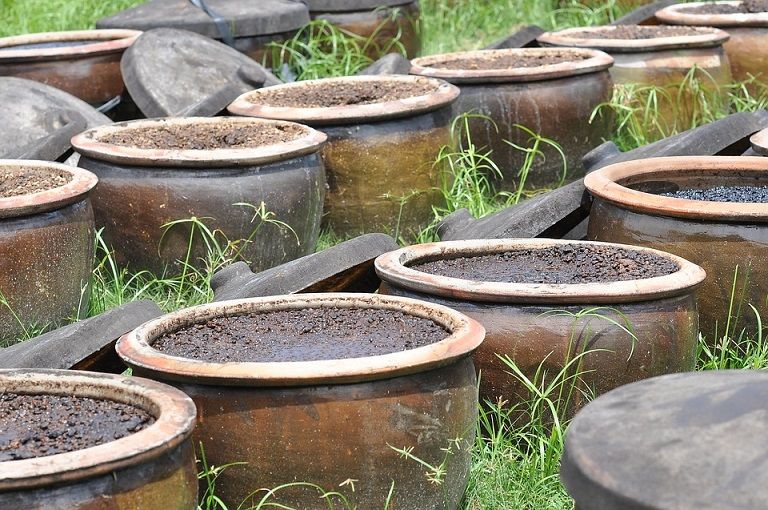FOOD FERMENTATION: PROVIDING FOOD FOR ALL.
Good day, thank you for reading my previous posts, today we will be discussing food fermentation. I have been wondering how food fermentation started in Nigeria and am yet to find an answer. Probably you can help me out. Was it because people were hungry and trying their hands on various things that could put food on the table or because someone told them that they could prepare food in various forms to get desired results?, Or where they doing this in ignorance. In fact, I really hope you can provide an answer to this question.
Fermentation of food is a metabolic or chemical process that involves the conversion of sugar (carbohydrate) in the absence of oxygen to alcohol, carbondioxide or organic acids by the activities of enzymes or in the presence of bacteria or yeast. Natural or traditional fermentation has been practised for centuries as the evidence of fermentation can be dated to 7000 to 6600 BC in Jiahu a village in China where alcohol was made from rice and fruits. So when did it start in Nigeria?
 )
)Traditional fermentation techniques (usually a household process) are employed for the various types of fermented foods products that are produced in developing countries. These food produced indigenously are acted upon by enzymes and microorganisms that are naturally present in the environment although in recent times they could also be added as a starter culture to give a beneficial and preferable biochemical change that modifies the food.
Having said that microbial interactions in the natural environment is necessary for the fermentation of food, the next question will be, is it all microorganisms (bacteria, fungi, viruses etc) that involved in the microbial fermentation of food?
To answer this question, it is important to note that this process is only successful in an anaerobic condition and acids such as organic acids (pyruvic, lactic, acetic, propionic, palmitic, formic and butyric acids), alcohols (ethanol) are produced, so organisms involved in this natural fermentation process are those that can withstand these conditions.
A group of organism that can be characterized as non-spore forming, Gram-positive, catalase negative spheres or bacilli and acid forming bacteria called the Lactic acid bacteria are important in natural fermentation. Examples include:
- Lactobacillus
- Leuconostoc
- Pediococcus
- Lactococcus
- Streptococcus
- Aerococcus
- Corynebacterium
- Enterococcus
Some yeast and moulds are also important in this process and they include:
- Saccharomyces
- Penicillium
- Aspergillus
- Botrytisare
The substrates required for fermentation can be obtained from any of the following:
- Roots and tubers
- Oilseeds
- Legumes
- Cereals
- Milk
- Sap
The substrates and microorganism needed have been mentioned, how then is the process achieved? Does the mere presence of these organisms in environments where legumes, cereals, milk etc are found activate fermentation?
There are different pathways that enables the fermentation of the substrate, alcohol fermentation where glucose is converted to pyruvate by glycolysis, Lactic acid fermentation that involves the conversion of pyruvate to lactic acid, mixed acid fermentation where acidic mixtures e.g. formic acid lactic acid, acetic acid, ethanol, are the end product, Propionic acid fermentation (propionic acid and Carbon dioxide are synthesised), Butanoic fermentation (pyruvate is converted into butanol or butyrate) etc, However, of all fermintation pathways the preparation locsally made nutritious and palatable food omly require the two parhways explained below.
- Lactic Acid Fermentation
The important organic responsible for lactic acid fermentation is Lactobacillus. During this process, lactic acid is produced and it is responsible for the sour taste. This method of fermentation has been used for centuries because it leads to the reduction of pH which improves the stability,safety and the shelf life of the food. Pathogens responsible for food spoilage such as Bacilli, Clostridia, enterobacteria etc cannot survive this acidic condition thereby making the food safe for consumption.
Lactic acid fermentation could occur through Homolactic fermentation or heterolactic fermentation. There are two major differences between both pathways.
The end product in homolactic fermentation is lactic while that of the latter is ethanol and Carbondioxide in addition to lactic acid.
Enterococcus, Streptococcus thermophiles, Lactobacillus bulgariu, Streptococcus lactis, and lactobacillus lactis are the organisms involved in homolactic fermentation while Leconostoc lactis, Leuconostoc mesenteroides and Lactobacillus fermentors bacteria involved in heterolactic fermentation.
- Alcohol fermentation.
- This is useful and important in the natural fermentation of substrate in the presence of Sacharomyces cereviseae leading to the production of beer, wine, distilled spirits and other fermented food products.
Classification of the Naturally Fermented Food in Nigeria.

Based on the substrate involved in the fermentation process, these food products can be classified into six.
Cereals: * Maize, Sorghum, Millet*
These substrates are naturally acted upon by Rhizopus oryzae, Aspergillus flavus, Penicillium funiculosum, Geotrichum candidum, Candida spp to produce Burukutu, masa, pito, ogi, ogi baba, kunu zarki etcTubers: cassava
Cassava is majorly fermented byStreptococcus lacticus, Lactobacillus spp, Leuconostoc spp, Geotrichum candidum and Corynebacterium manihot. The end products of cassava fermentation are major food sources for the Nigerian populace. Lafun a powder that results from the fermentation of cassava. This product is majorly consumed by people in south-western Nigeria. Another product is Fufu which appears in pastry form is made by cutting and steeping of the cassava in water for two to three days thereby allowing fermentation to take place naturally in the presence of microorganisms. Fufu is usually consumed by the southern Nigerian communities.
Apart from* fufu and lafun, Garri is a white, yellow or creamy product of the natural fermentation of gelatinised cassava tubers. Garri generally consumed in Nigeria and other West African countries e,g Ghana and in some part of Europe and Australia,
- Oilseeds: African locust beans Parkia biglobosa) and soya beans

Iru (as called by the Yoruba speaking Nigerians), is popularly called Dawadawa by the northerners especially among the Hausa people is a food supplement fermented from African locust beans (that is not edible when not fermented) and popularly used for flavouring of soup. It is also rich in protein and therefore contribute protein intake of people who cannot afford to purchase meat or fish.
Melon seeds (Citrullus vulgaris) are usually fermented by Bacillus spp, Escherichia spp, Proteus spp and Pediococcus sp into Ogiri which is used by people from eastern Nigeria as a food condiment. There are two other types of Ogiri, apart from the one produced from melon seeds, one of which is Ogiri-is that is prepared using the castor seed (Ricinus communis) and Ogiri-ugu that is prepared from the popular fluted pumpkin (Telfairea accidentalis) with Bacillus spp, Pseudomonas spp and Staphyloccus spp as organisms identified as the fermenters.
African Oil bean (Pentaclethra macrophylla)
Ugba a nutritious food produced from African oil beans which is naturally toxic is also nick named the African salad. Staphlococcus spp and Bacillus spp have been identified to be associated with its fermentation process.Milk
Nono, wara-kishi and Local cheese are milk products usually prepared by nomadic Hausa farmers and fermented by natural or local process. Raw milk from either goat or cow is important to achieve desirable product and the organism that is associated with these products are Lactic acid bacteria and examples are as listed aboveOil palm sap
The sap of Raffia hooeri or Elaeis guinensis trees have been fermented naturally to produce Palm wine. Palm wine is very important to the people of the Eastern Nigeria and others who use palm wine for celebrations. Usually palm wine after production is not usually alcoholic but after a few hours alcoholic content increases to about 5% which could also be desirable for those who love alcohol. The Organisms that have been associated with the fermentation of this wine includes Saccharomyces cerevisiae, Streptococcus spp, Candida tropicalis, C. Utilis, Lactobacillus brevis and Bacillus spp.

Conclusion
Fermented food has been able to provide food for everyone, without considering ethnicity, age, sex, social economic factors etc. Majority of individuals residing in Nigeria, must have tasted or consumed one or more of the food products listed above, considering the fact that food fermentation is accomplained with the following benefits:Food fermentation is important for the preservation of food; it also helps to increase its shelf life.
Helps to improve the taste, texture, nutritional value; digestibility and flavour of the food in question
Food fermentation is also important for the removal of toxins.
Fermentation is primarily used in the preparation of complementary foods (e.g ogi or ogi baba) thereby playing a major role in the feeding of children especially those below the age of two.
Please note that all images not referenced are MINE
References
- https://www.google.com/url?sa=t&rct=j&q=&esrc=s&source=web&cd=9&cad=rja&uact=8&ved=0ahUKEwipsNyZ0-naAhVrAsAKHTKGA74QFgiFATAI&url=http%3A%2F%2F14.139.206.50%3A8080%2Fjspui%2Fbitstream%2F1%2F1361%2F1%2FIndian-Food-Ind%2520(1998).pdf&usg=AOvVaw0o0AHGApFAsZ34R8_1gqp2
- https://www.tandfonline.com/doi/abs/10.1080/03670244.1990.99911145
- ncbi
- researchgate
- biologywise
- omlinebiologynotes
- https://www.google.com/url?sa=t&rct=j&q=&esrc=s&source=web&cd=4&ved=0ahUKEwiI69euu-7aAhXoJcAKHWYICmEQFghVMAM&url=https%3A%2F%2Fwww.ejmanager.com%2Fmnstemps%2F54%2F54-1430931125.pdf&usg=AOvVaw3rnQil3VPJgUtUukbOohc9
Very cool to read about the common fermentation practices in Africa. I've always been intrigued by how most cultures develop fermentation independently. I'm guessing because its one of the most effective ways to preserve food. If that's the case, then it was probably developed in Nigeria before adequate record keeping.
Nice work :)
Thank you for reading, I agree with you that it was developed before adequate record keeping but why won't they keep records, maybe if they have, I would have found an answer.
Congratulations @ugonma! You have completed some achievement on Steemit and have been rewarded with new badge(s) :
Click on any badge to view your own Board of Honor on SteemitBoard.
For more information about SteemitBoard, click here
If you no longer want to receive notifications, reply to this comment with the word
STOPQuite indigenous. I guess we were curious, and it proved worthy. Look at the awesome delicacies we found for ourselves.
Nice input. Keep it up
Thank you for reading and your response, yea we were really curious.
You're welcomed.
Keep steeming..
Much about fermentation @ugonma. Actually I can't really say I have answer to the question on the first paragraph, however, Africans have their own Science and technology before the white came. So I guess we can trace it back to time in the past when there was no record. All the way, this post is quite educative on topic
Fermentation is indeed important, most food substance we consume undergoes fermentation. I appreciate this post, most especially the names of the yeasts and moulds involved in the process
Thank you for appreciating the post and commenting.
I knew about food fermentation, but almost nothing about how it's used in Nigeria. Really informative, and a tasty read.
THANK YOU FOR READING AND COMMENTING